[Notebook] System Diagnostics within MyASUS in WinRE - Introduction
MyASUS in WinRE is an easy-to-access diagnostic tool that works inside the Windows Recovery Environment (WinRE) and is designed to give you seamless support. It consists of a full set of diagnostic tests that can help you identify and troubleshoot hardware problems. These handy tools are already installed on your ASUS PC or laptop, and you can access them at any time, even if the operating system is not running or won't boot. The simple software interface is intuitive and easy to use, and gives you access to instant assistance.
If the diagnosis result shows that the component is abnormal, MyASUS in WinRE will provide QR Code, test report and diagnosis code. You can scan the QR Code with your mobile phone and other devices
- MyASUS WinRE is available on ASUS PC devices under Microsoft operating system, on devices using processors with or later than Intel 10th Generation and AMD Ryzen 4000 series.
- Services may vary by countries. Please check the service information on ASUS support page.
- You must agree to the MyASUS in WinRE privacy policy in order to upload test results to the Service Request system.
If you cannot use MyASUS in WinRE, you can use the system diagnosis function in MyASUS in UEFI. Click: [Notebook] System Diagnostics within MyASUS in UEFI - Introduction
If your model [FX506LH, FA706IH, FA706IHR] can not directly enable System Diagnostics within MyASUS in WinRE function, please try the tool [MyASUS in WinRE for USB] to execute the system diagnostic function.
If you want to know more about the Cloud Recovery function in MyASUS in WinRE, please click: [Notebook] Cloud Recovery within MyASUS in WinRE - Introduction
- How to open [MyASUS in WinRE]
- Settings of MyASUS in WinRE
- Component testing
3.1 Simple test - SSD test
3.2 More complex test - Wi-Fi test
3.3 More complex test - Display test
3.4 More complex test - Touchpad test - What should I do when "failure" appears in the test report?
- Test History
- The meaning of the three test results
1. How to open [MyASUS in WinRE]
After pressing the power button of your computer, quickly press F12 several times to enter [Choose an option] Interface. Click [Troubleshoot] then click [MyASUS in WinRE]. Function key required may vary, depending on PC model. Some models use the F9 key instead.
Within Windows, Click Start, then click Power, then press and hold the Shift key while clicking Restart. Your PC will shut down and then reboot into WinRE. Once you are in WinRE, select MyASUS in WinRE.
* If MyASUS in WinRE is not found when opening this interface, the computer does not support this function.
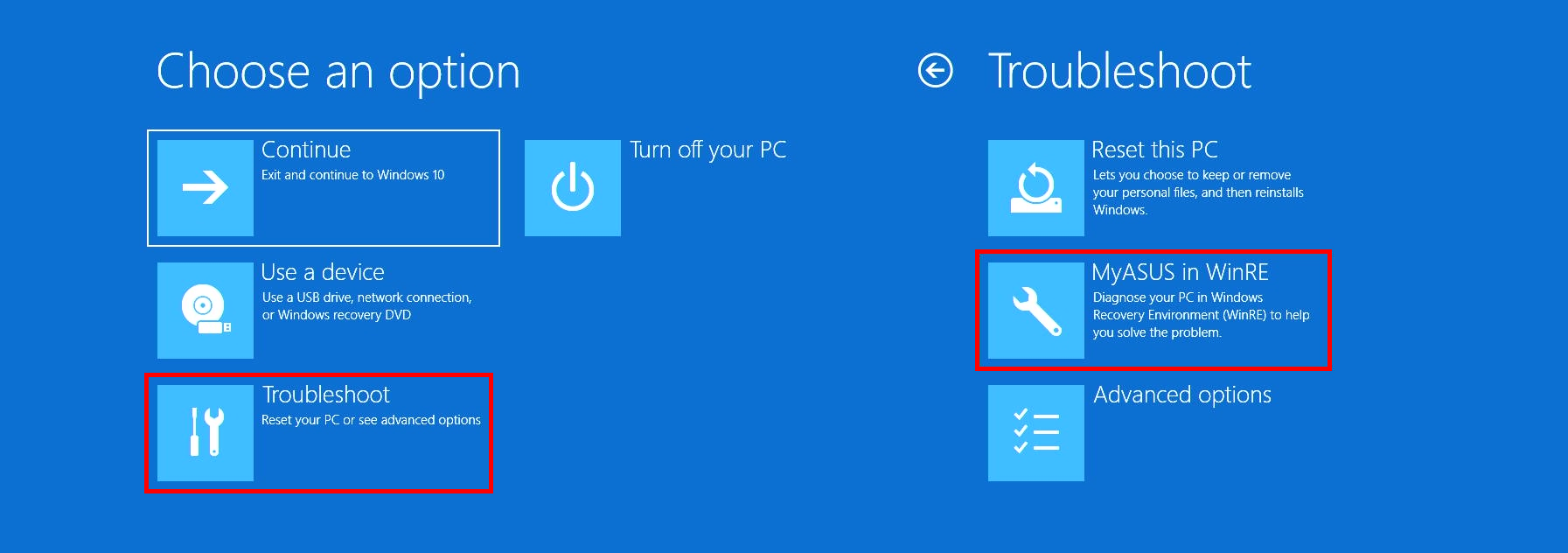
2. Settings of MyASUS in WinRE
2.1 If you enter MyASUS in WinRE for the first time, the Privacy Notice pop-up window may appear, please click [Agree].
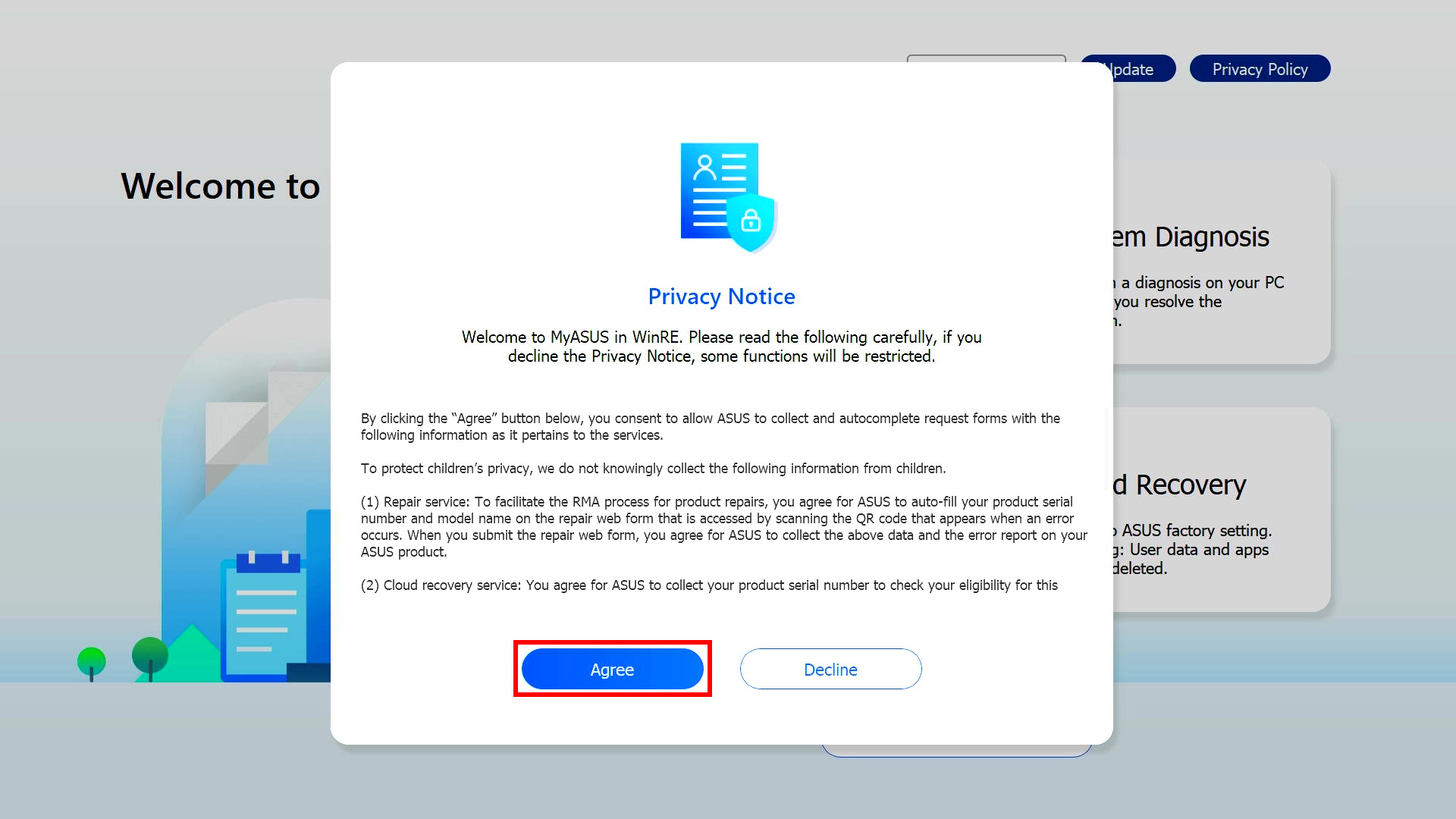
2.2 Language
(1) Click [Lanuage]① to choose your lanuage.
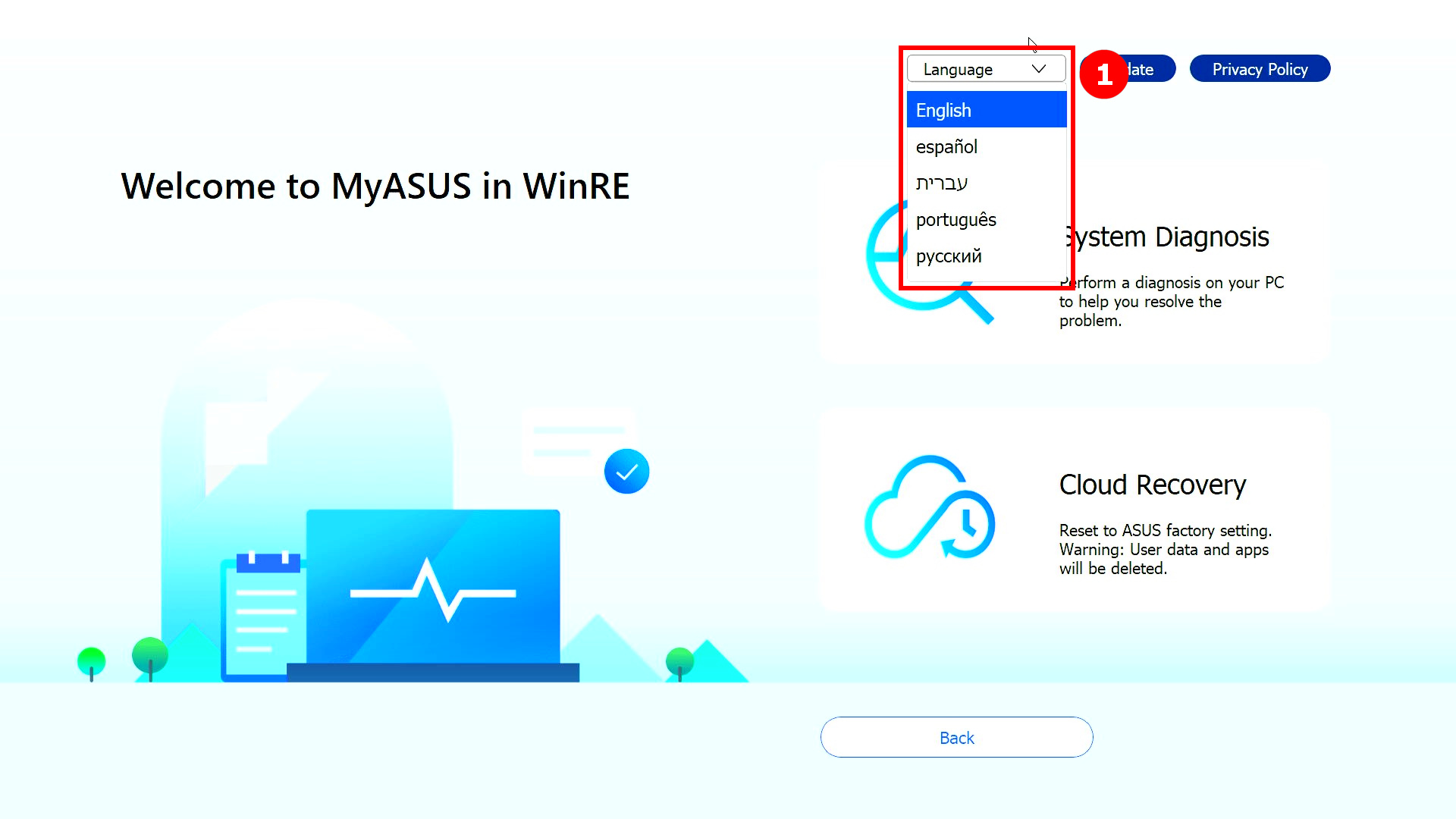
2.3 Update MyASUS in WinRE
Click [Update]②, click [OK]③ to update MyASUS in WinRE.
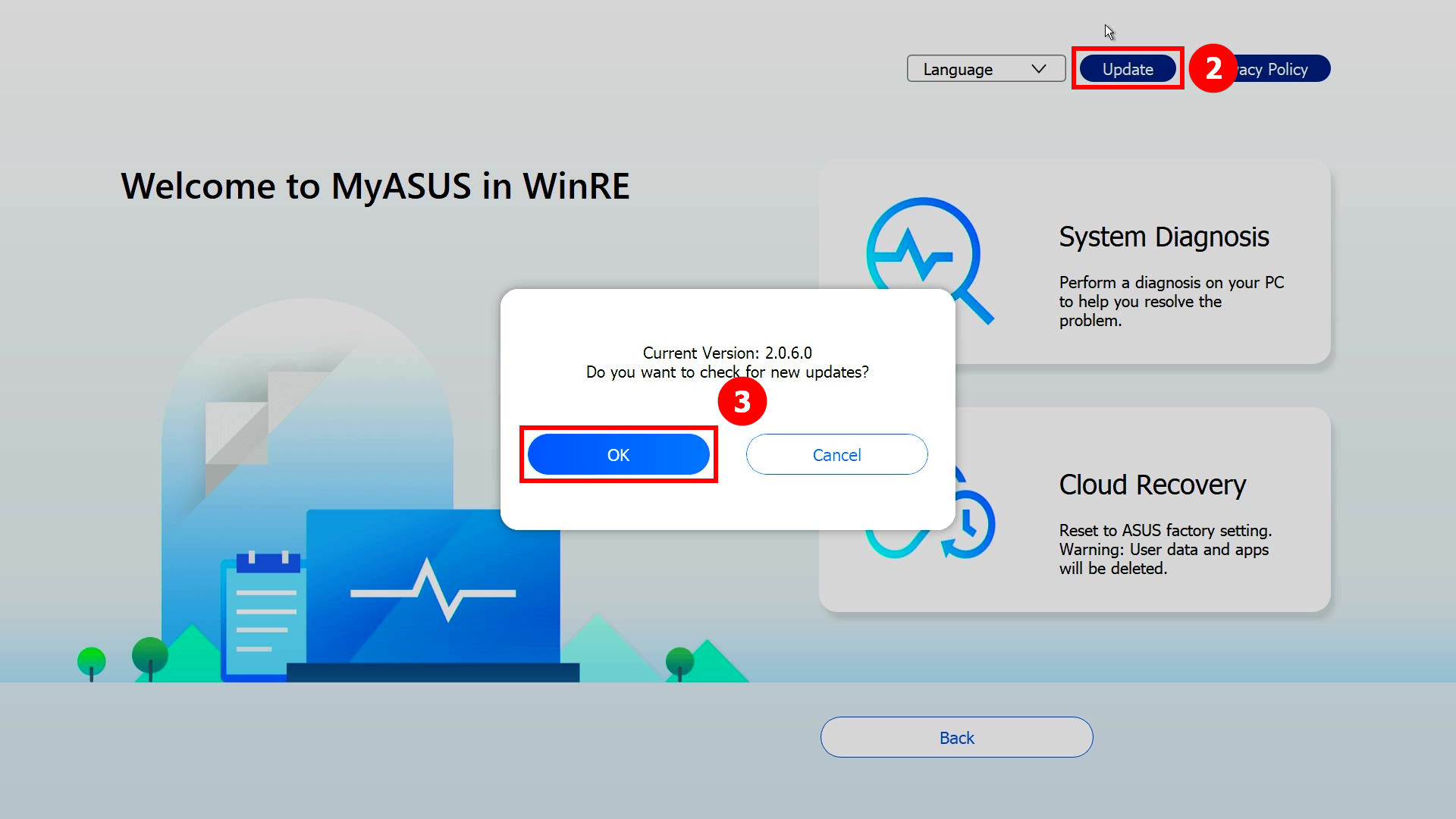
2.4 Privacy Policy
(1) Click [Privacy Policy]④, you will see Privacy Notice Page, click [View Privacy]⑤.
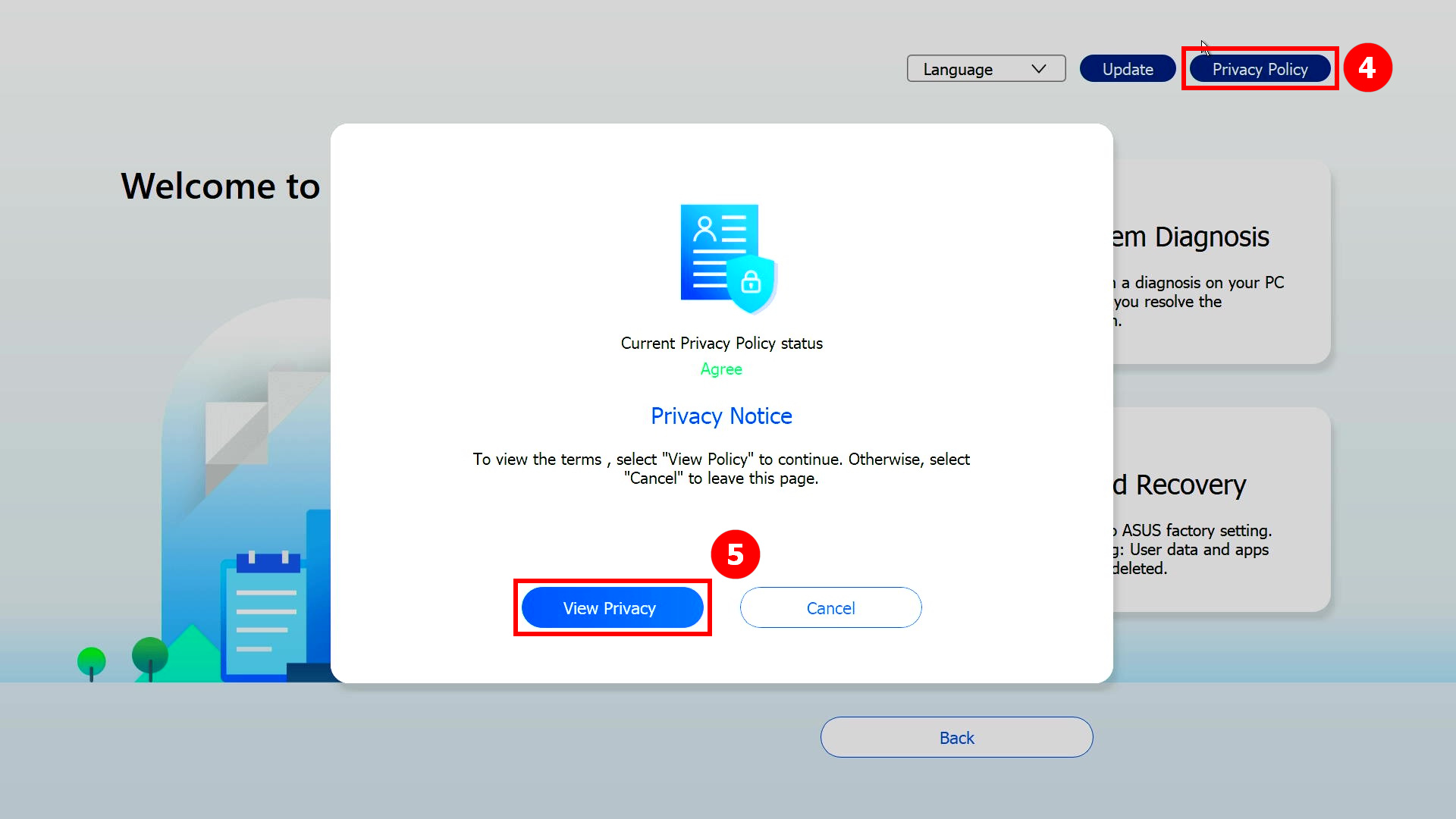
(2) You can choose either [Agree]⑥ or[Decline]⑦.
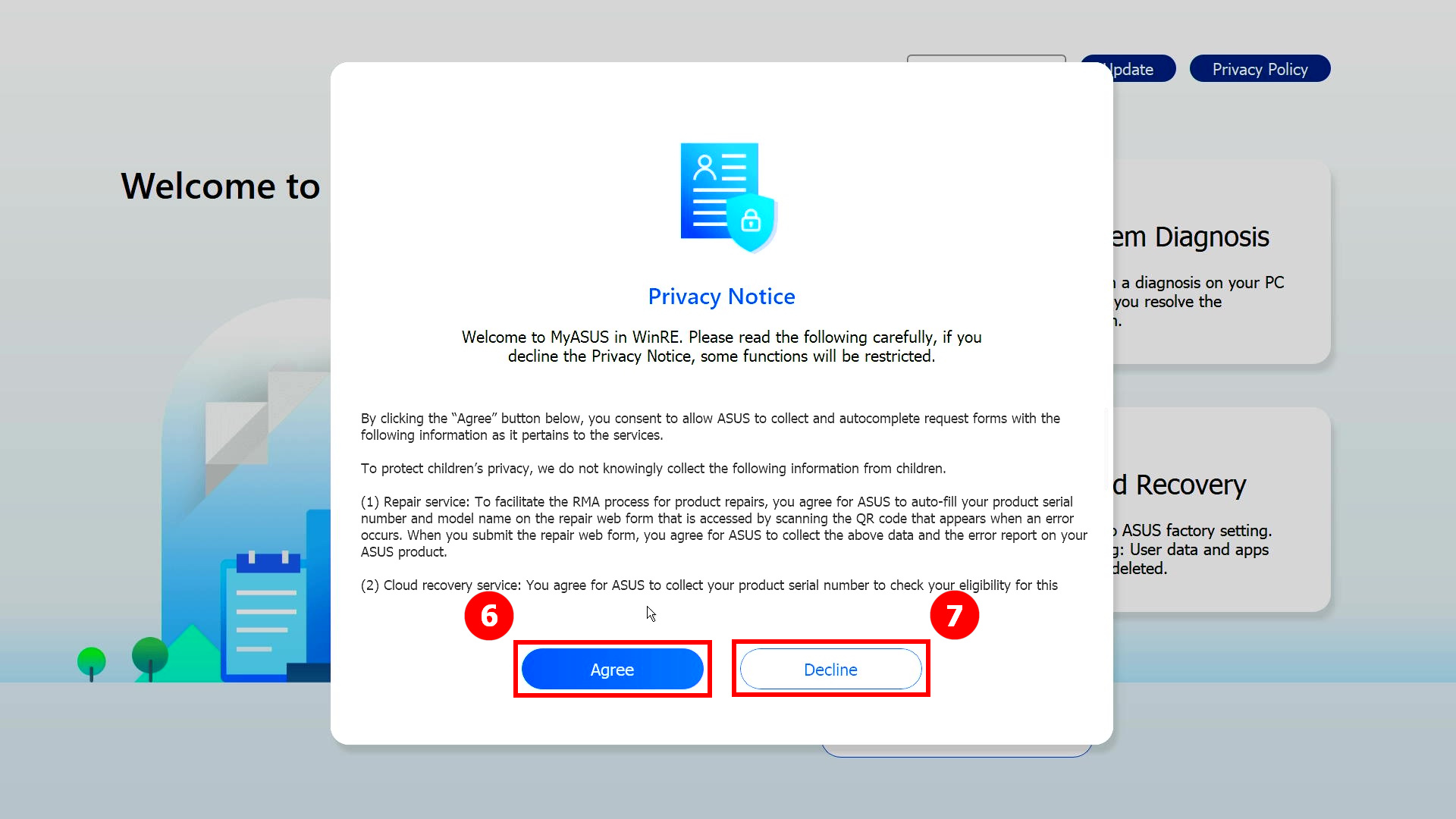
(3) Difference between Agree status and Decline status on Privacy Notice:
Agree status: In the state of agree, the machine code and diagnostic code of the computer will be recorded in the QR code. Scanning the QR code with your mobile phone will open the ASUS Repair Page. Since you have agreed to the Privacy Statement, the repair form already contains the computer's machine code and diagnostic code. Now you only need to fill in your personal information and the computer's status and pickup information, and ASUS will carry out the pickup and repair.
Decline status: In the state of disagreement, the QR code will not record the computer's machine code and diagnostic code. Compared with the "Agree" state, the "Decline" state requires you to fill in the computer's machine code and diagnostic code yourself, which increases the difficulty of applying for repairs. It is recommended that you agree to the privacy statement.
(The following two pictures are screenshots of "Agree and Decline" of the privacy statement. You can see that the QR code in the consent state contains more information so the information you need to manually fill in will be less.)
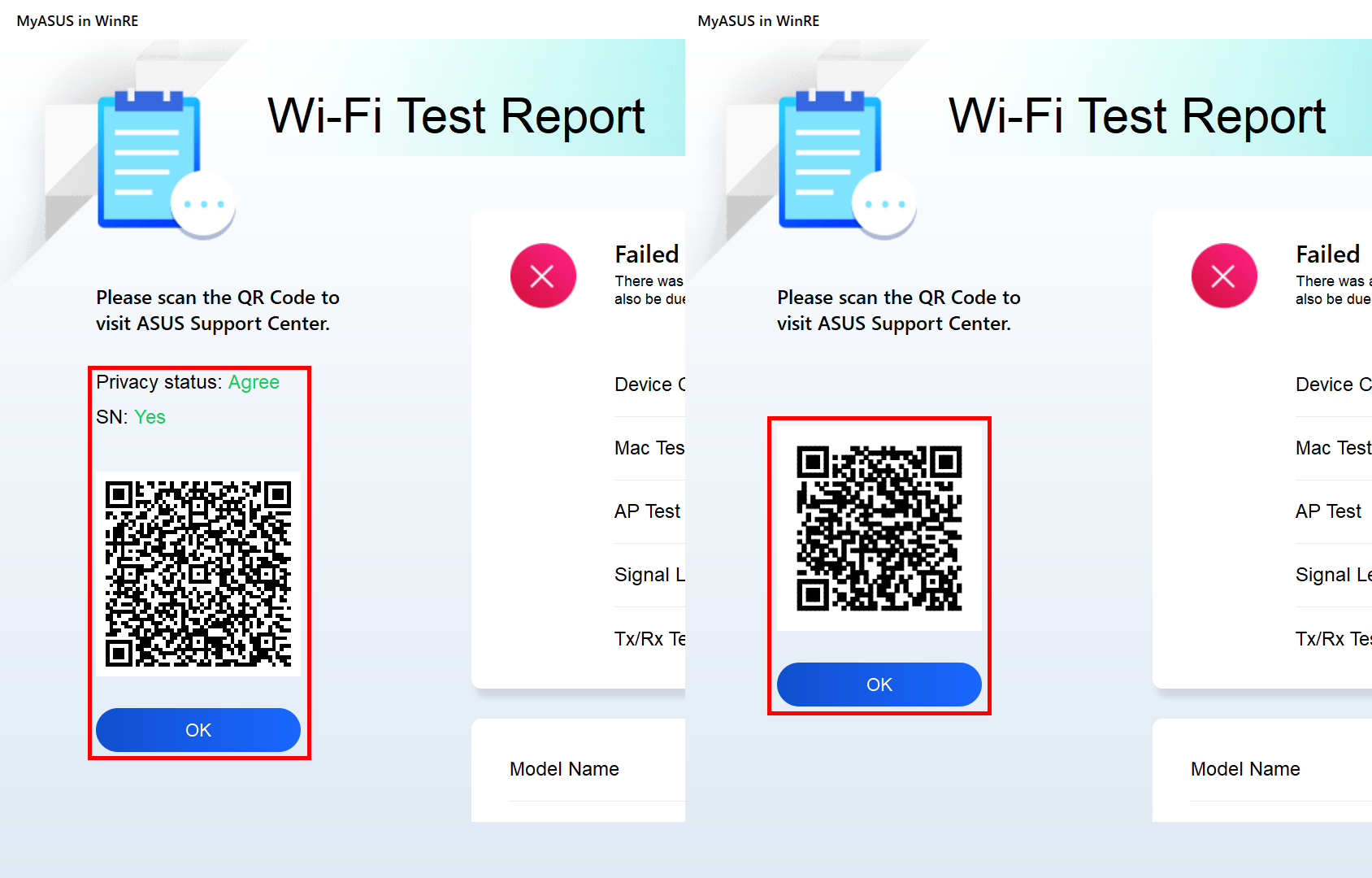
2.4 Settings done, click [System Diagnosis]⑧ to enter MyASUS in WinRE interface.
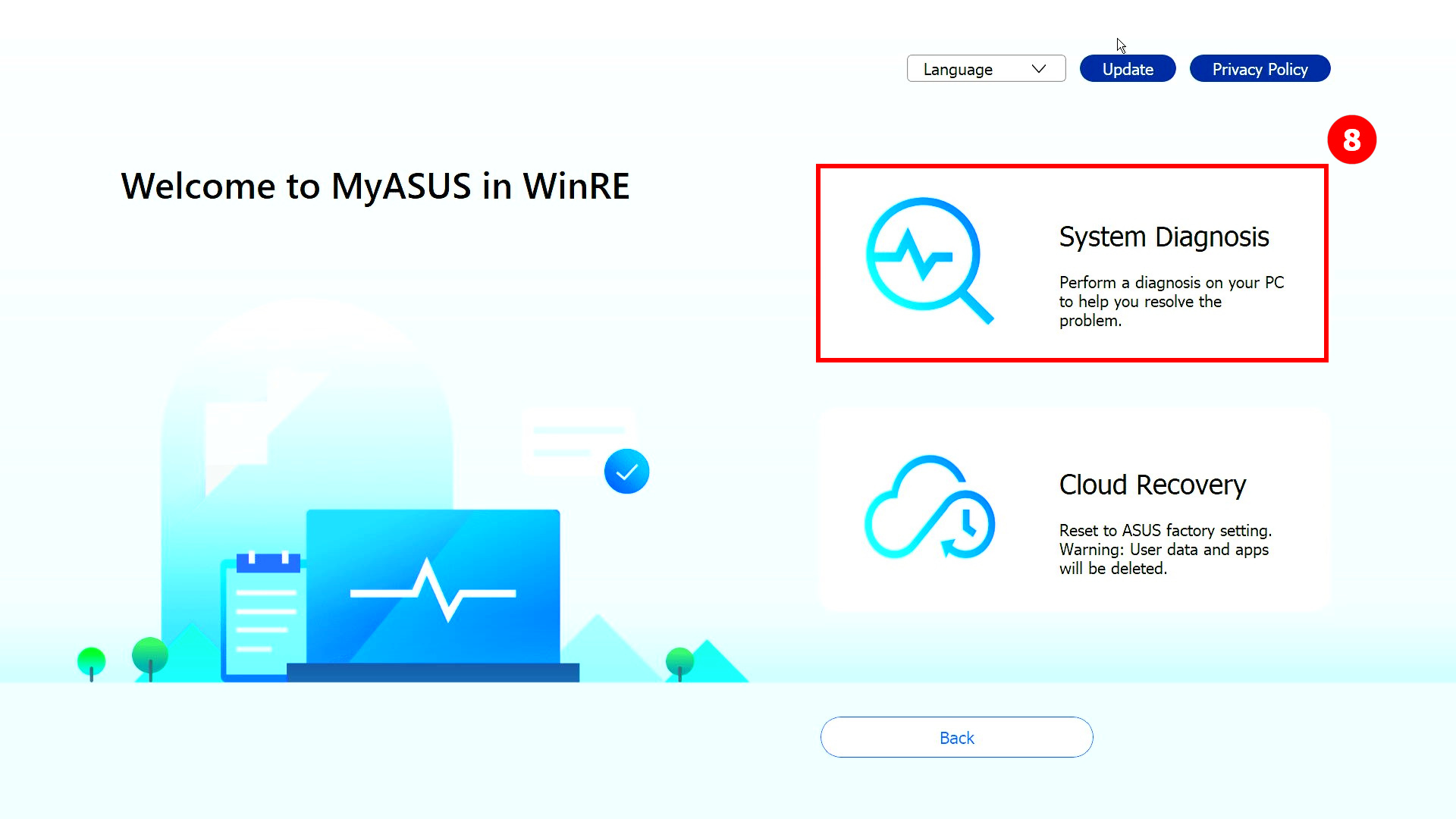
3. Component test (Take SSD as an example).
3.1 Take the simple component test, HDD, as an example to introduce the test process. Please follow the below picture guide for the operation (The test process of HDD, Power, Fan and other components are similar to the test process of HDD. Please refer to the HDD test process for your testing).
In Point 3.2, 3.3 and 3.4 of this article, we will introduce more complex test items: Wi-Fi, display, touchpad.
(1) Click [Checkup]① to start the test.
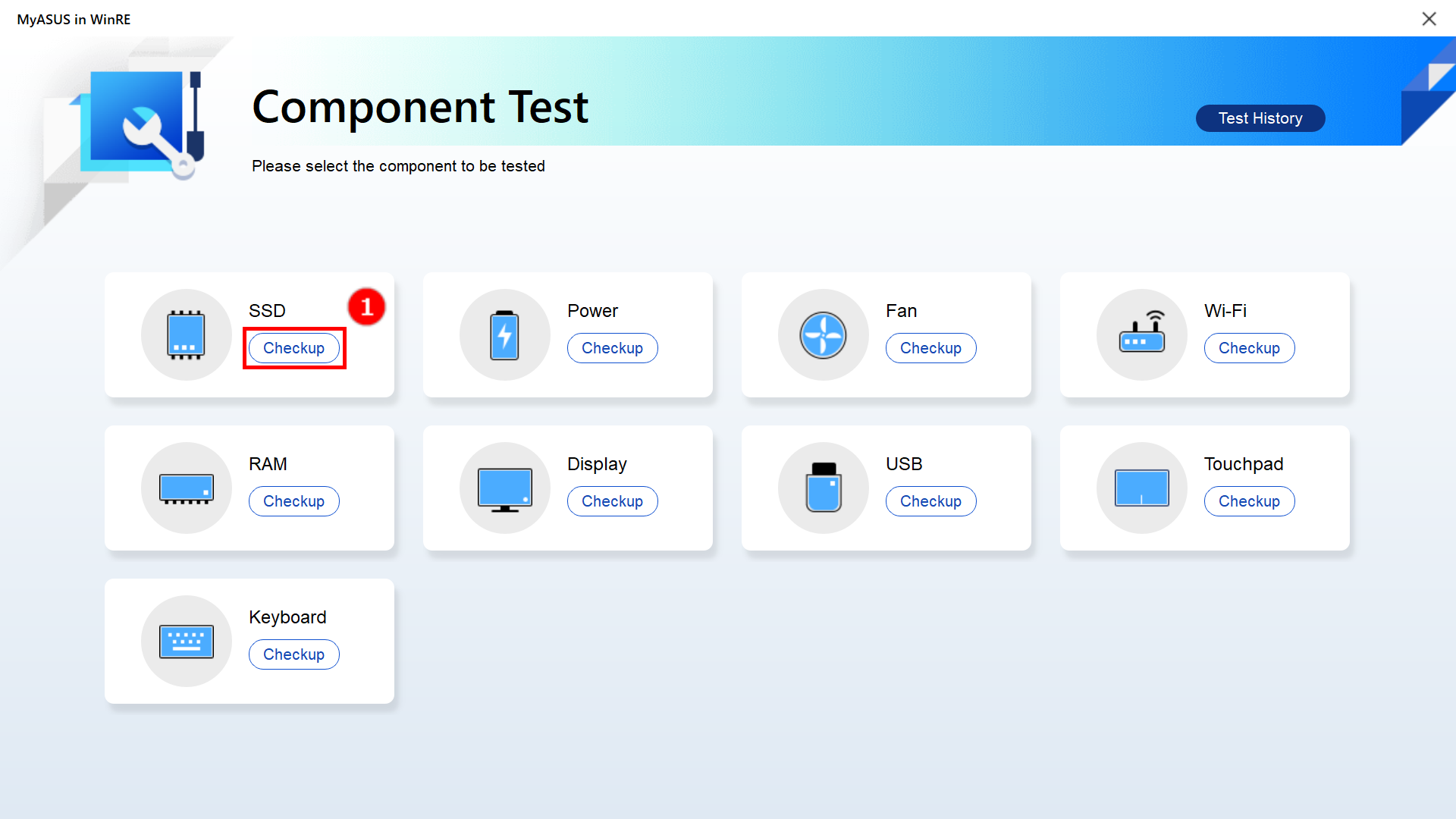
(2) Click [Quick Test]②.
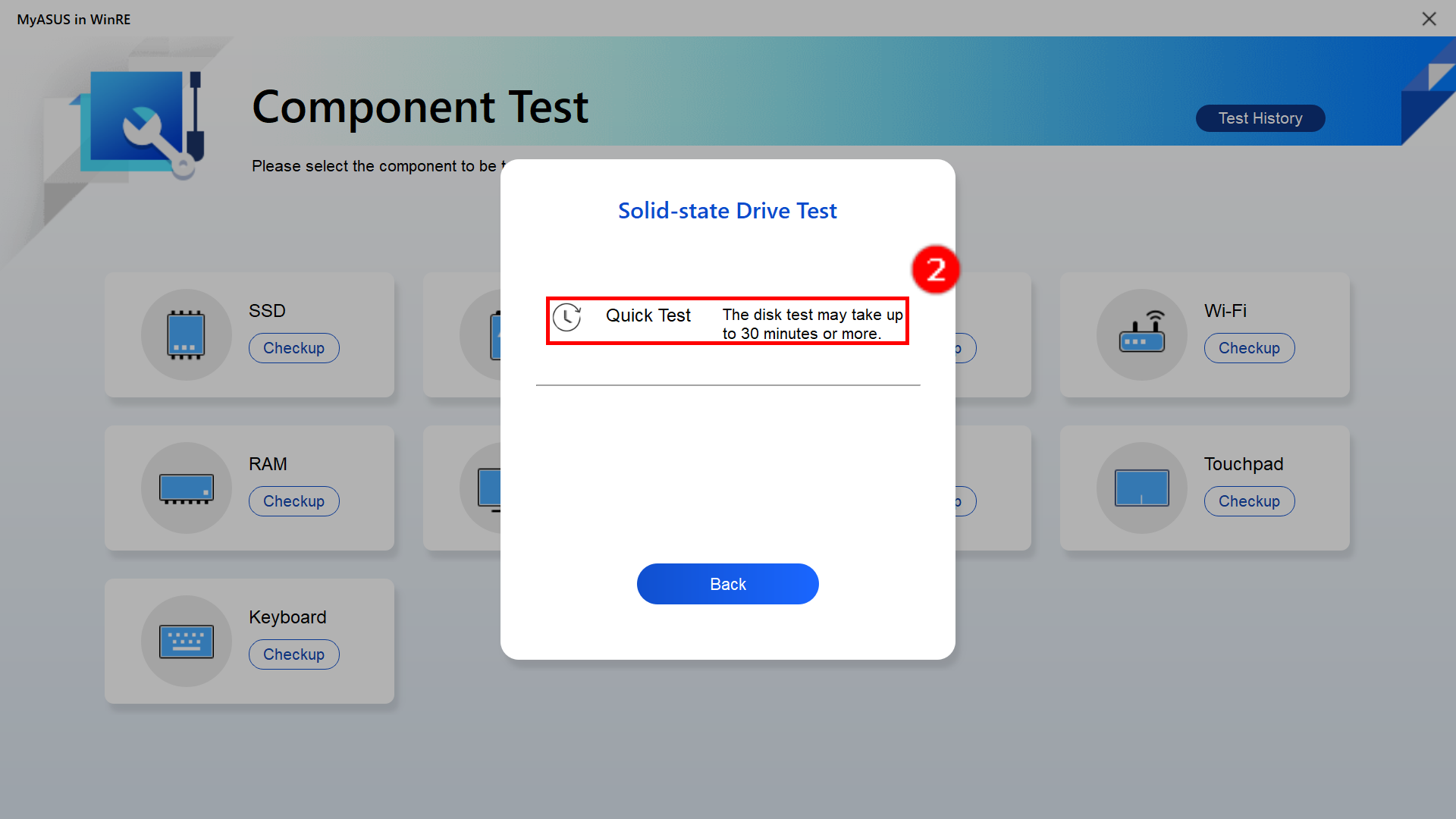
(3) Click [SSD]③.
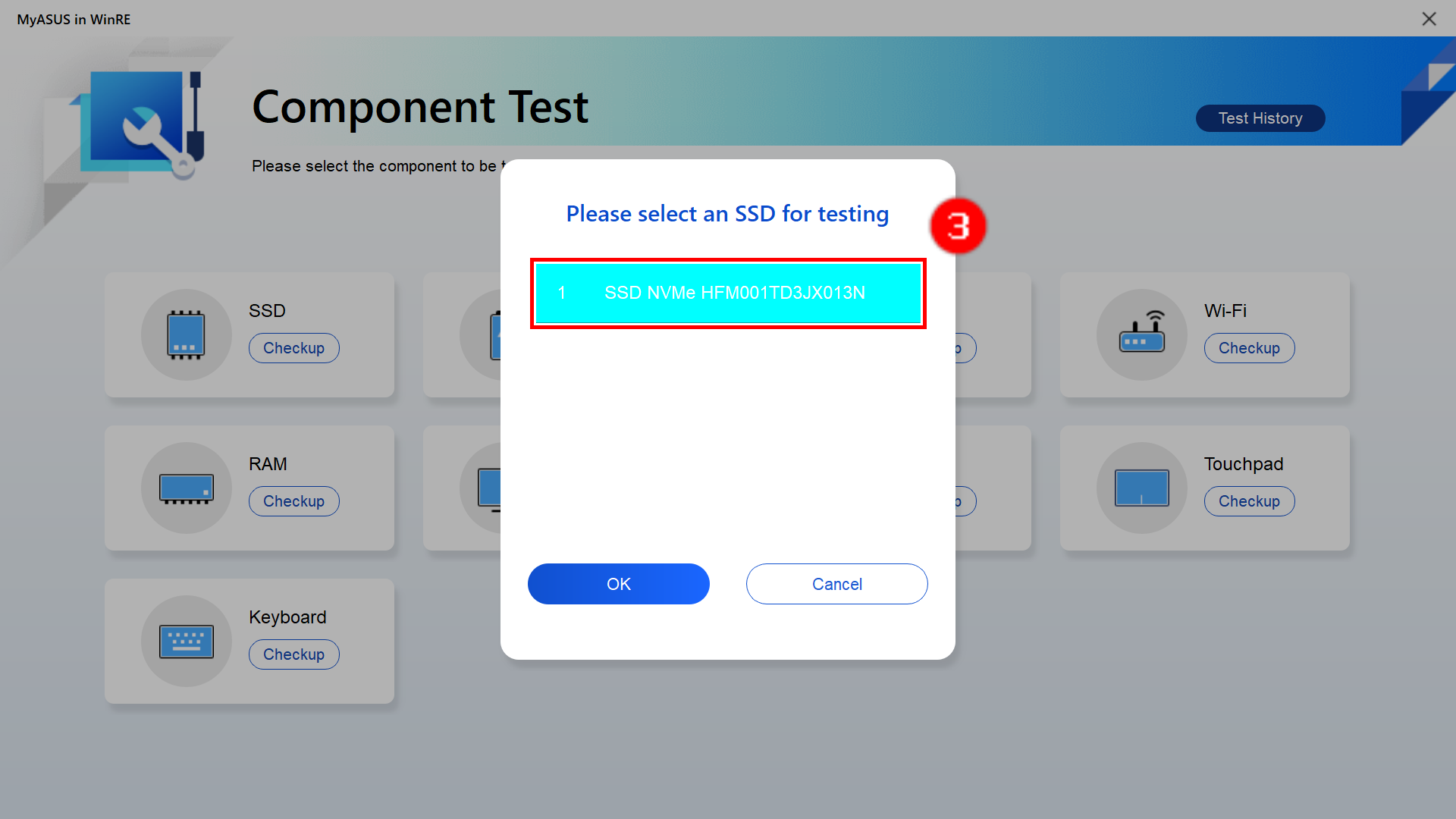
(4) Test passed, and click [OK]④.
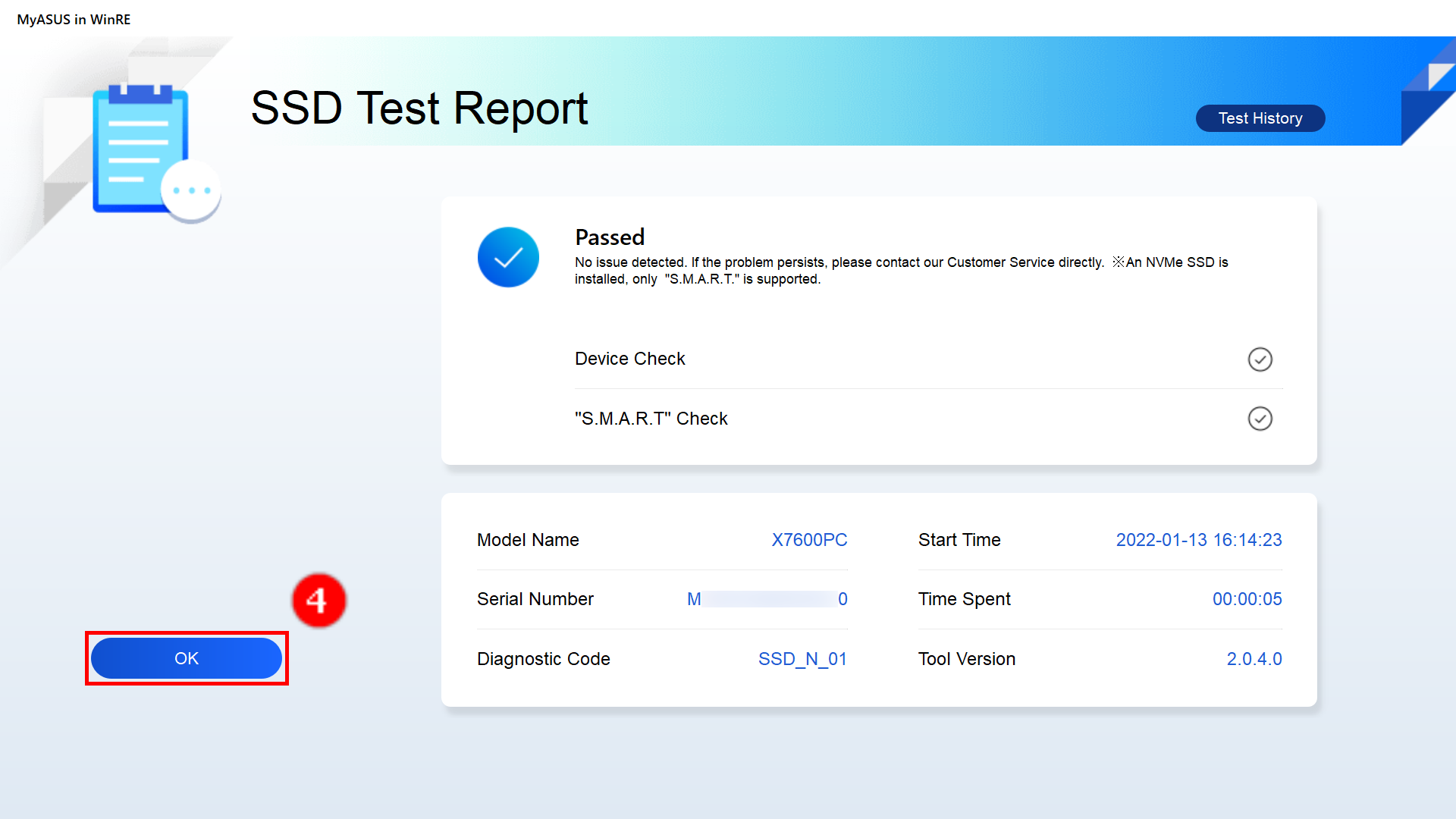
3.2 More complex test - Wi-Fi component test.
(1) Click [Checkup]① on the main interface.

(2) A window will pop up and requires you to connect to a wireless network. Find your [Wireless Network]②, and click [OK]③.
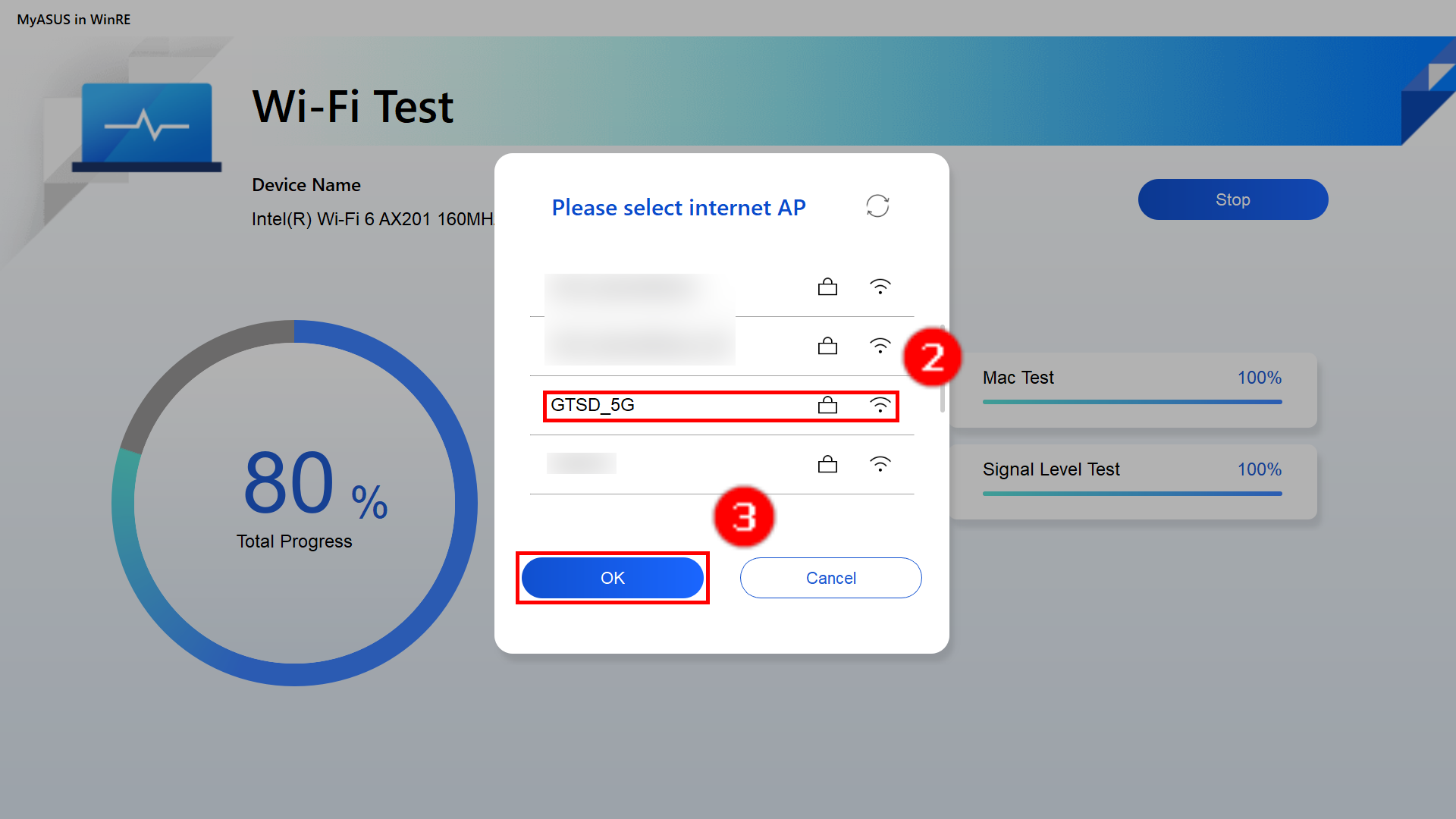
(3) Fill in your Wi-Fi [password]④ and click [Connect]⑤.
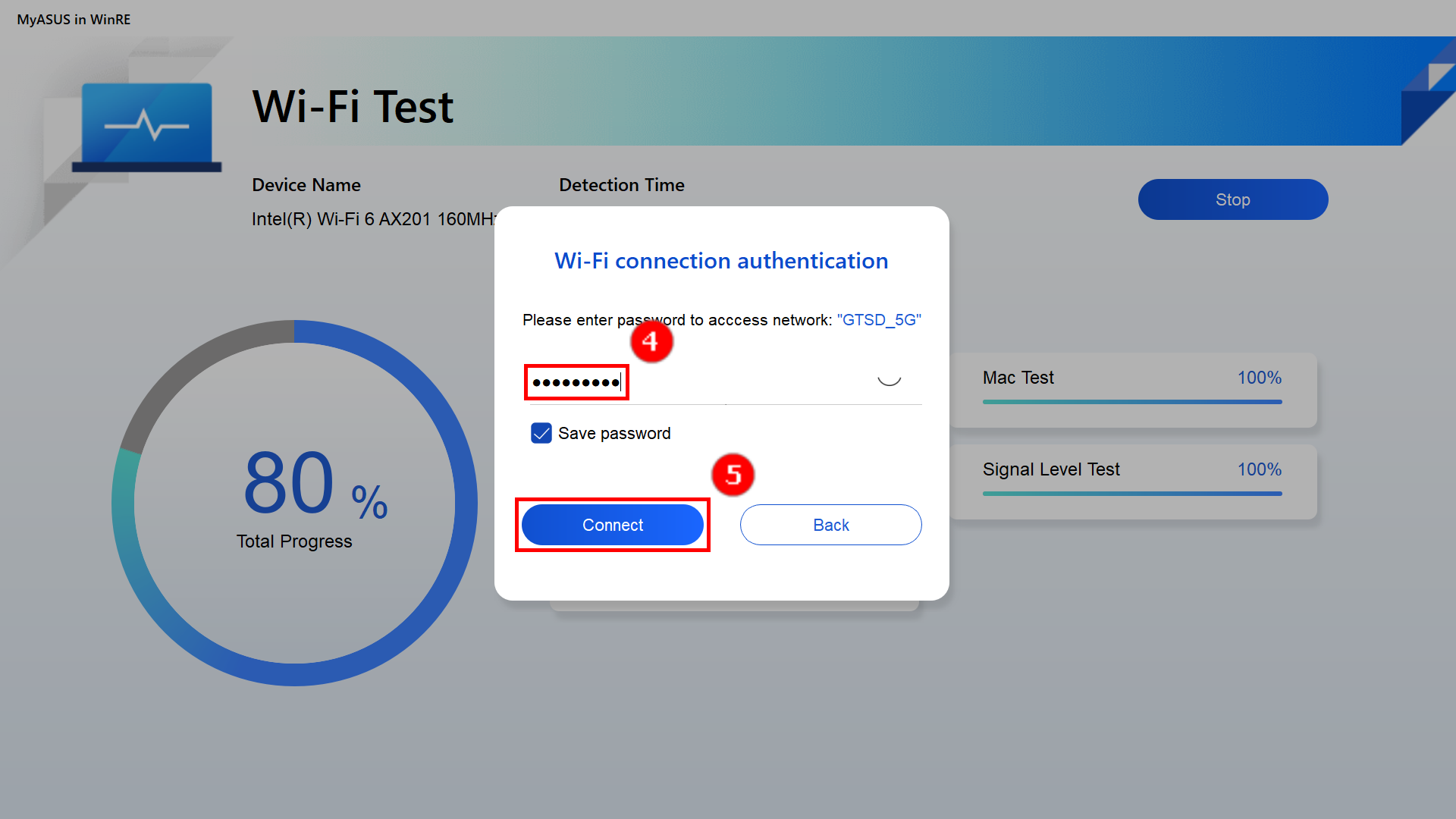
(4) The test passed, click [OK]⑥ to exit.
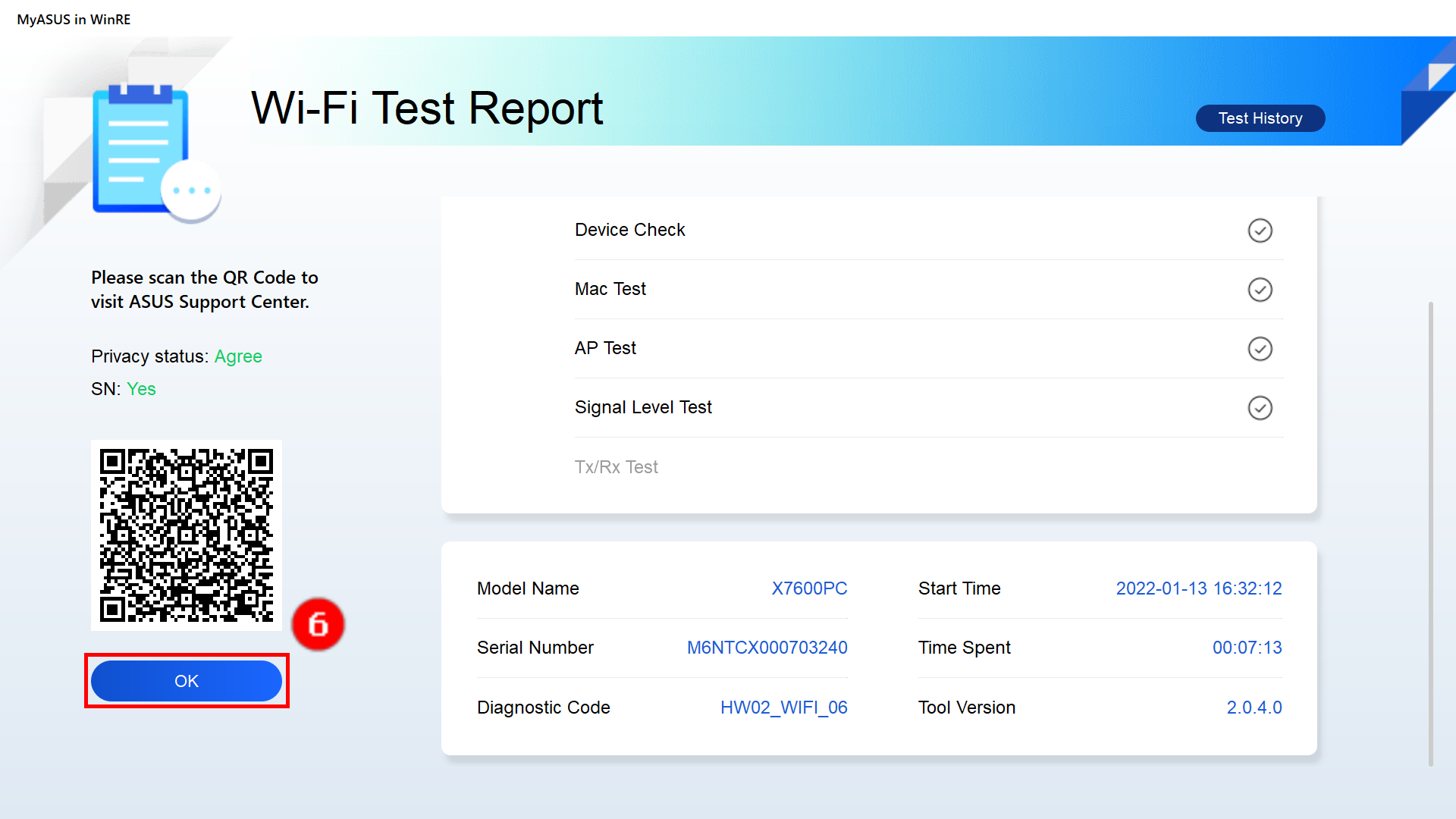
(5) If TRx test failed appears, there may be problems with the connected wireless network. Please make sure that the wireless network is unblocked, and then test again. If you are connected to a normal wireless network but the test result still fails, follow the instructions in Section 4 of this article.
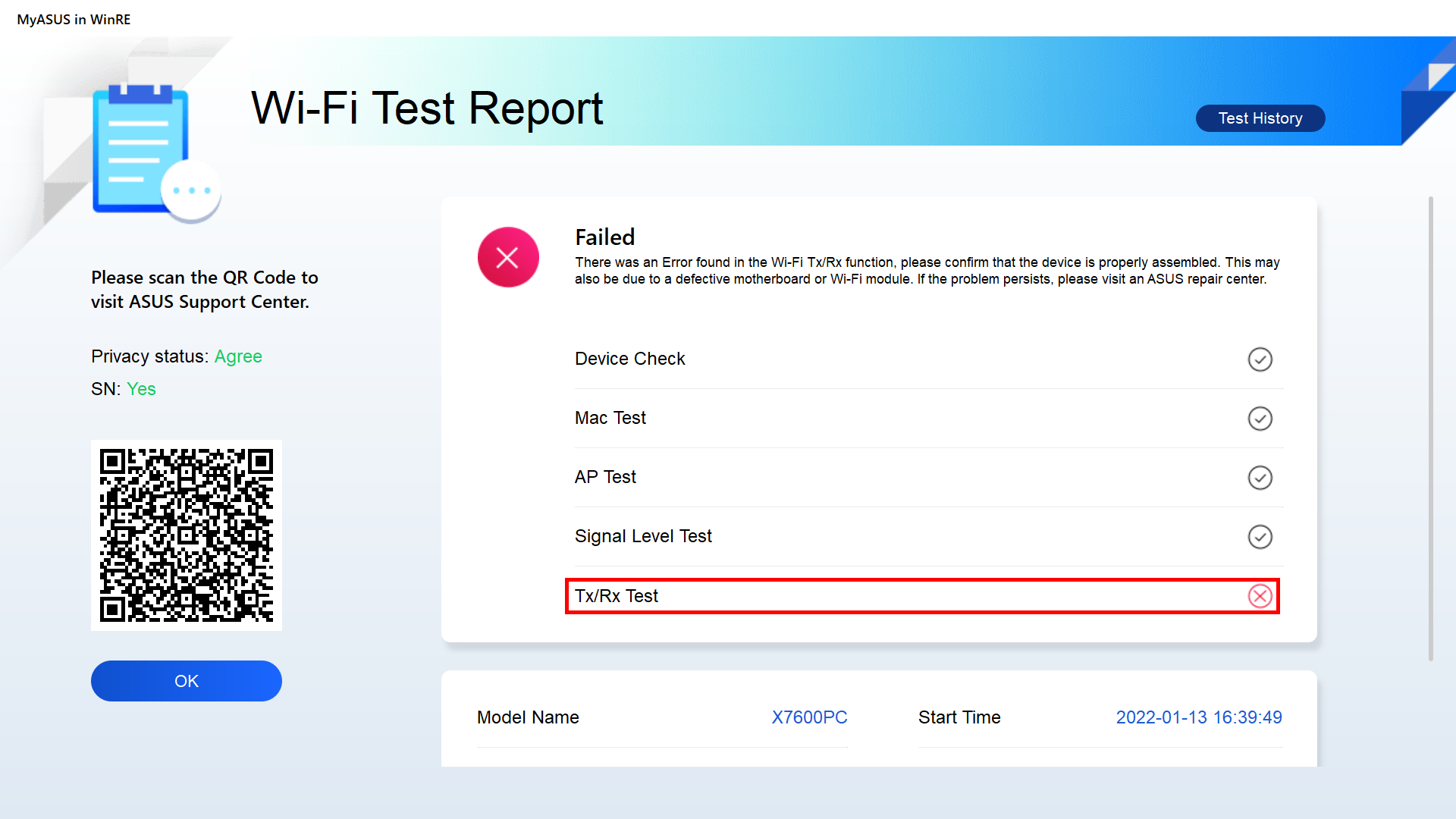
3.3 More complex test - Display test.
(1) Click [Checkup]① on the main interface.

(2) The following screen will appear, and click [OK]②. The user is required to judge whether the screen display is normal with the naked eyes. If it is normal, please click [Pass]③ to enter the next test. If there is any problem with the display, please click [Fail]④.
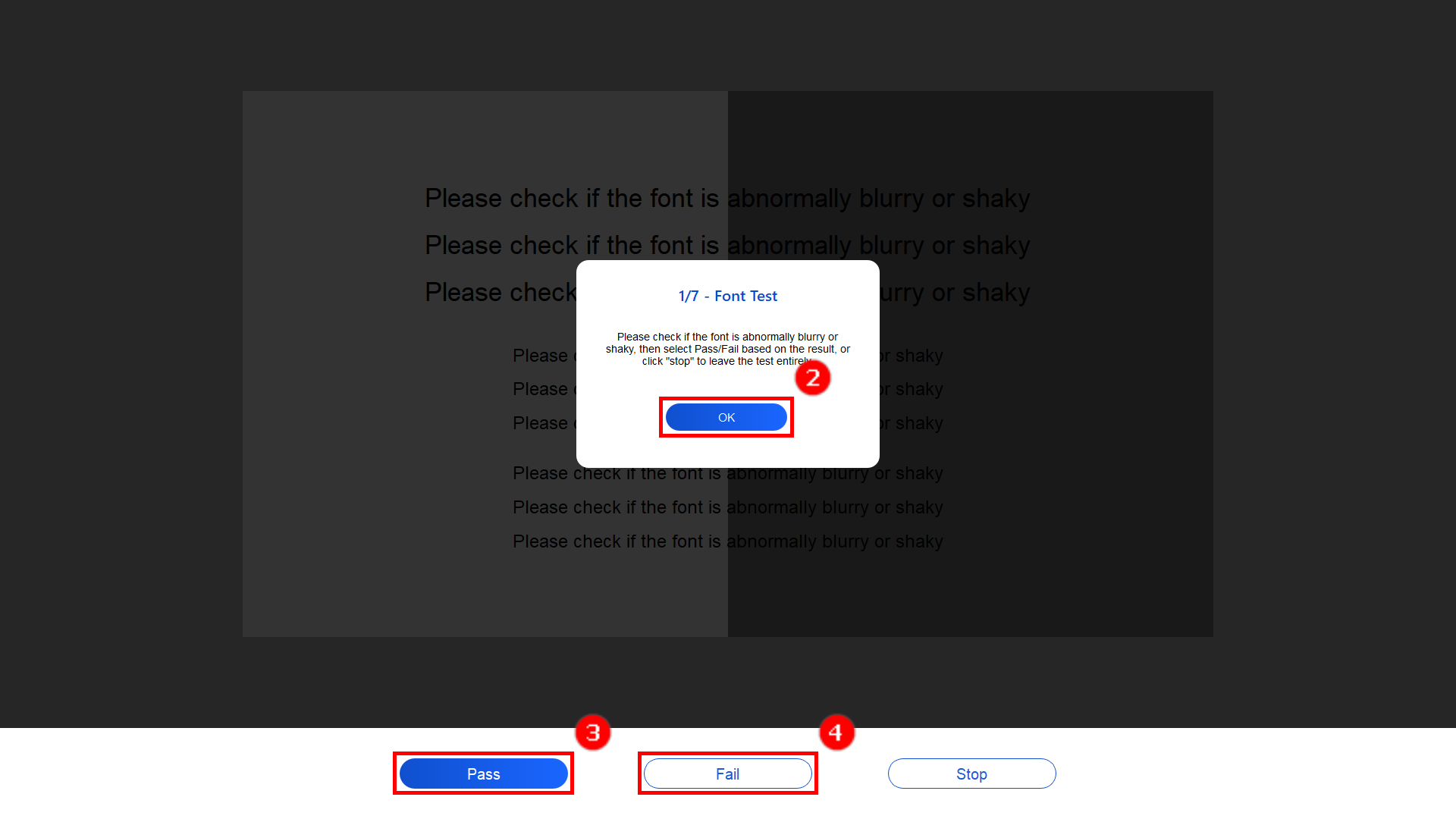
(1) Click [Checkup]① on the main interface.
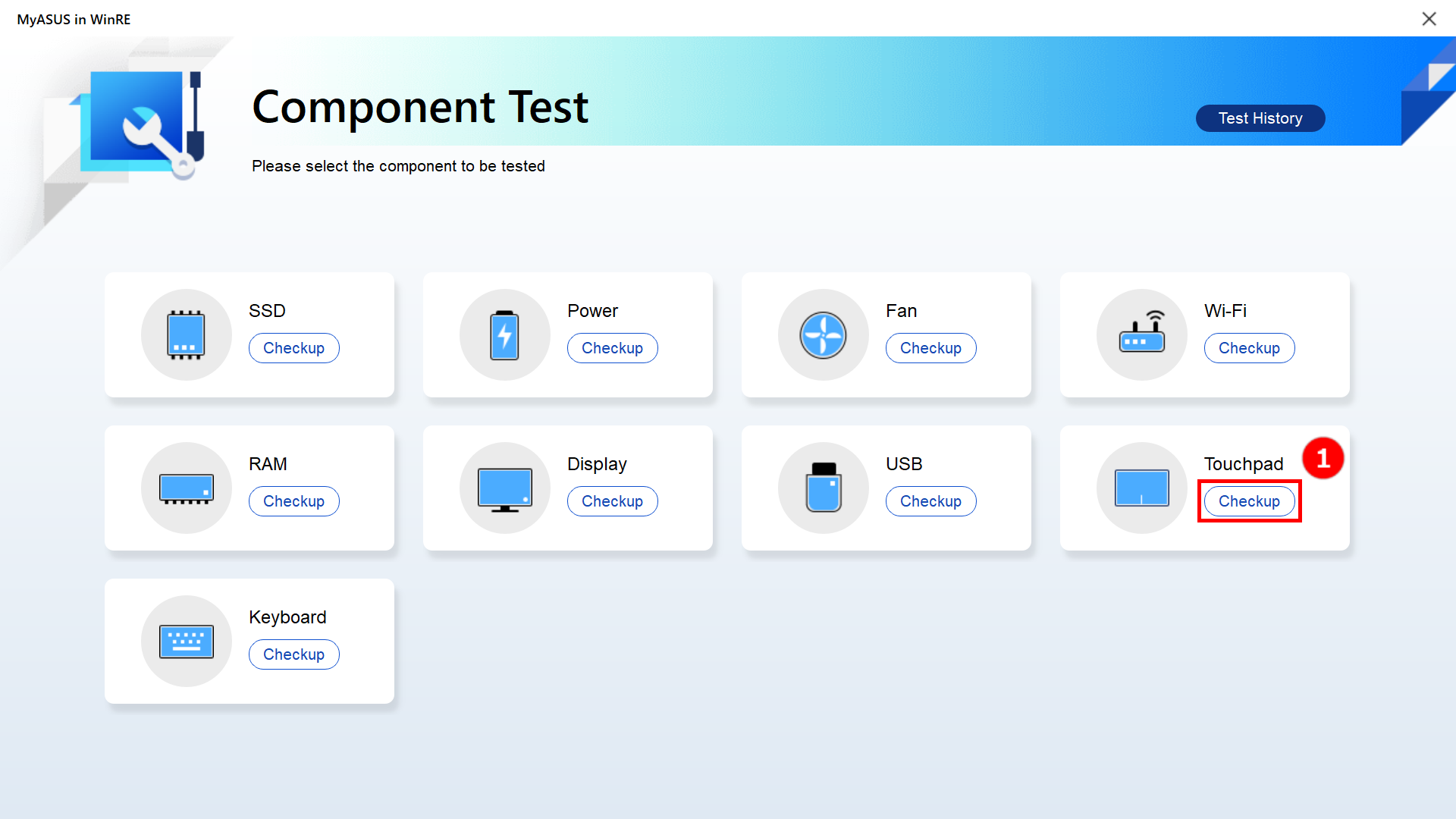
(2) Click [OK]②.

(3) Use your finger to tap [Area]③, which are: click, left-click, right-click.

(4) Move the cursor over [Blue Slider]④ with your finger, then drag the blue slider to the most right end.
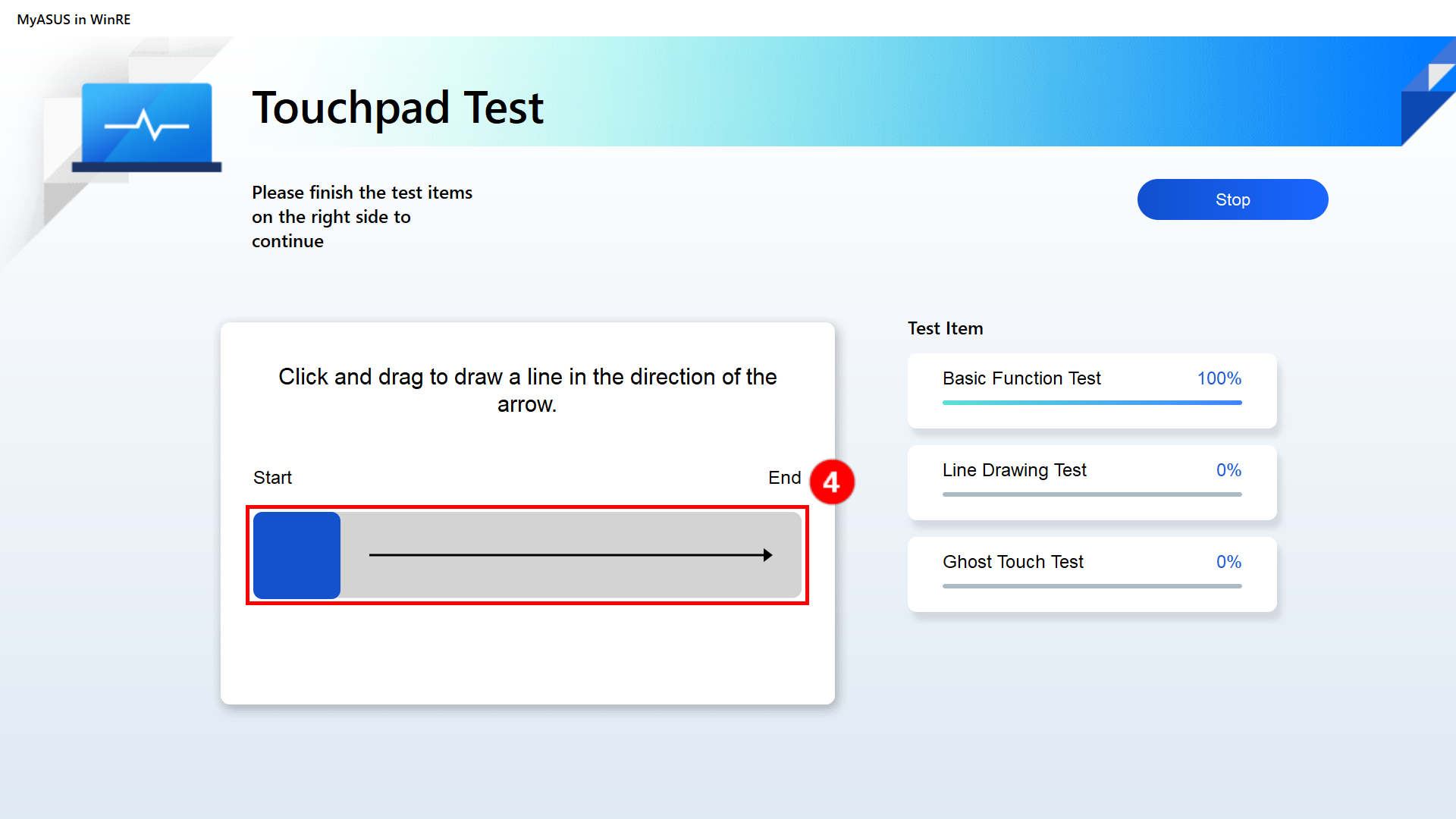
(5) Move the cursor over [Blue Slider]⑤ with your finger, and then drag the blue slider to the most bottom side.
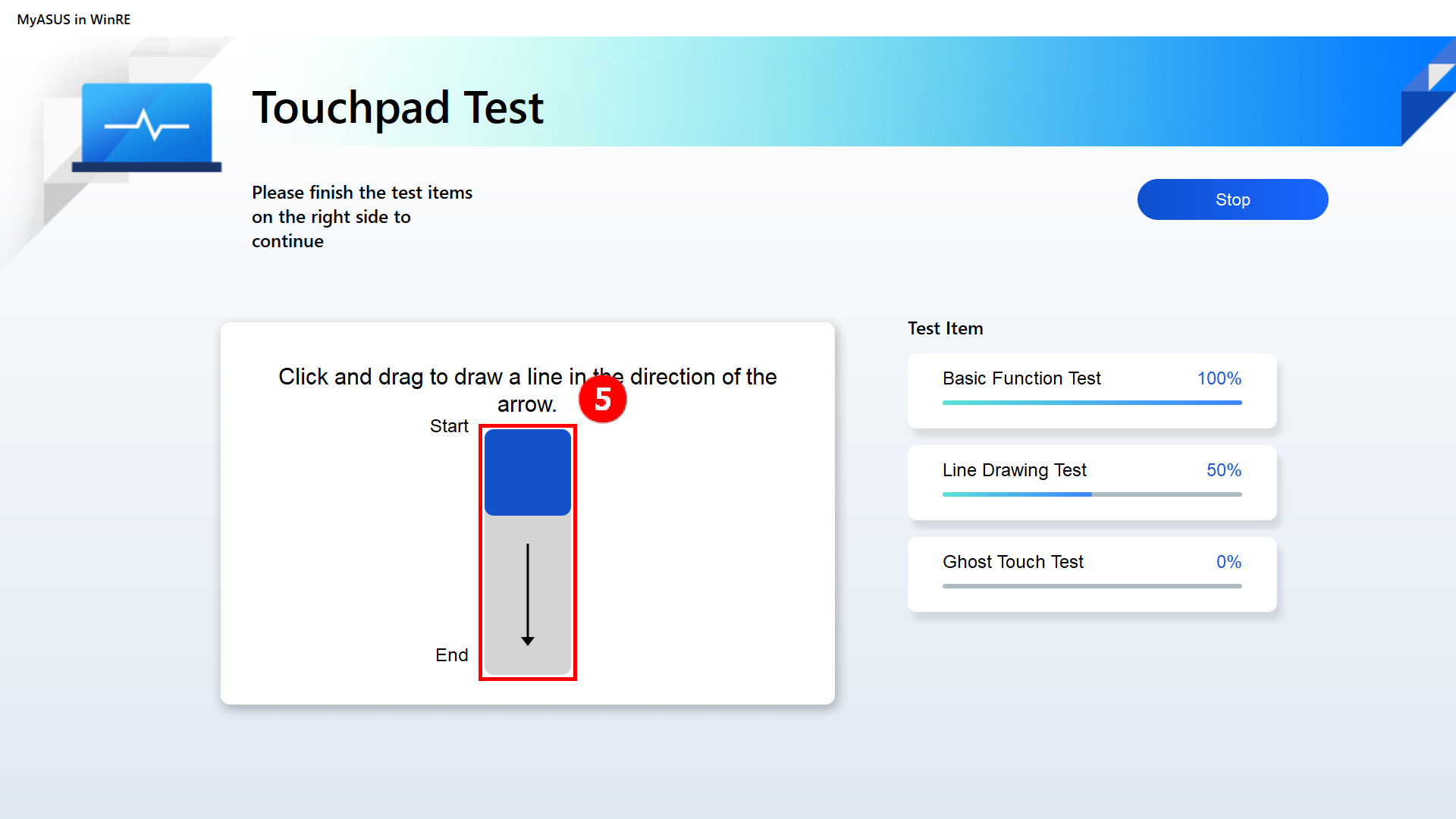
(6) Please select an option [15 seconds or 1 minute]⑥ to begin the ghost touch testing. Do not touch the touchpad during ghost touch testing.
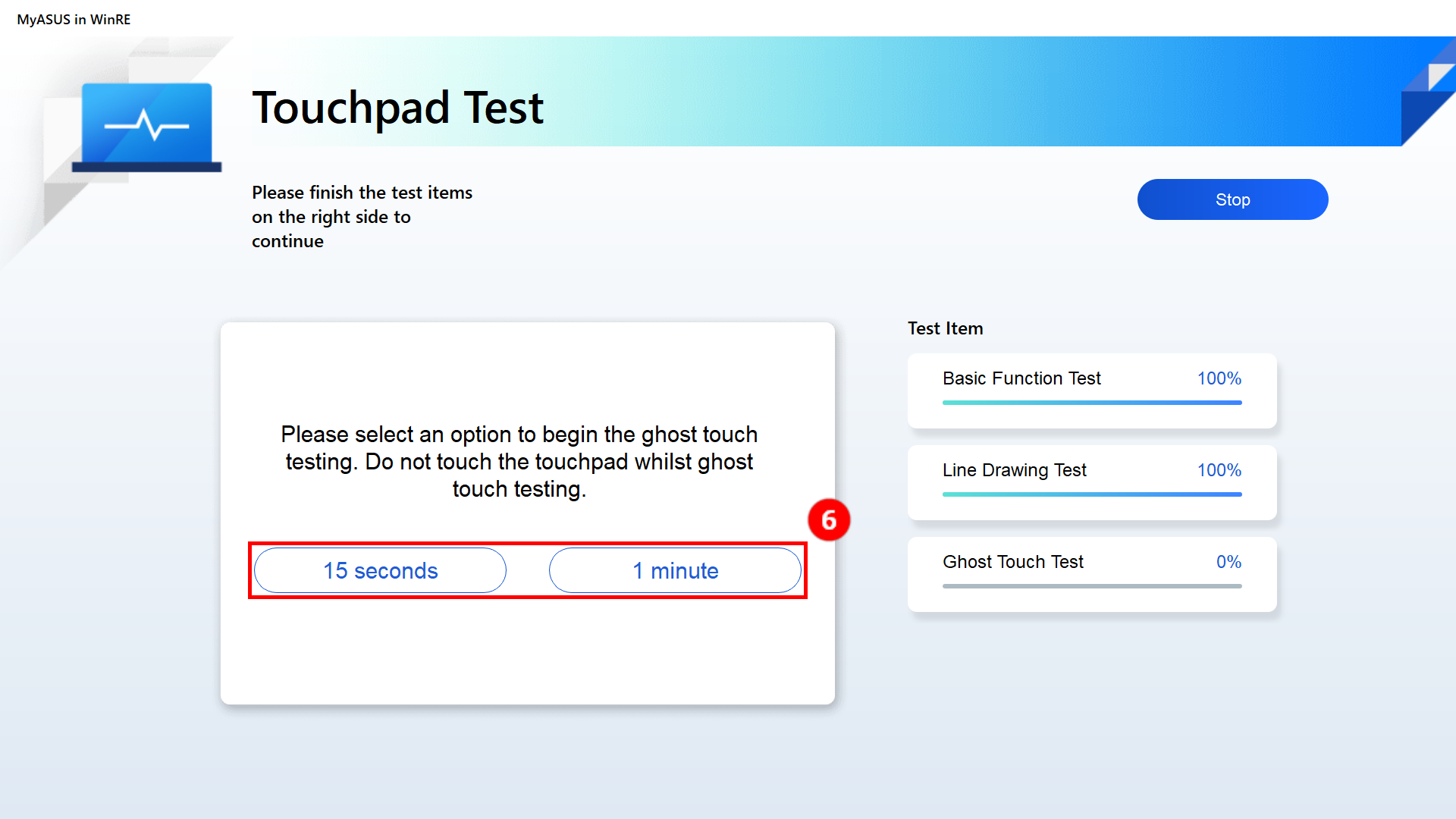
(7) The ghost touch test is in progress. Please do not touch the [Touchpad]⑦.

(8) Touchpad test passed, click [OK]⑧ to exit.
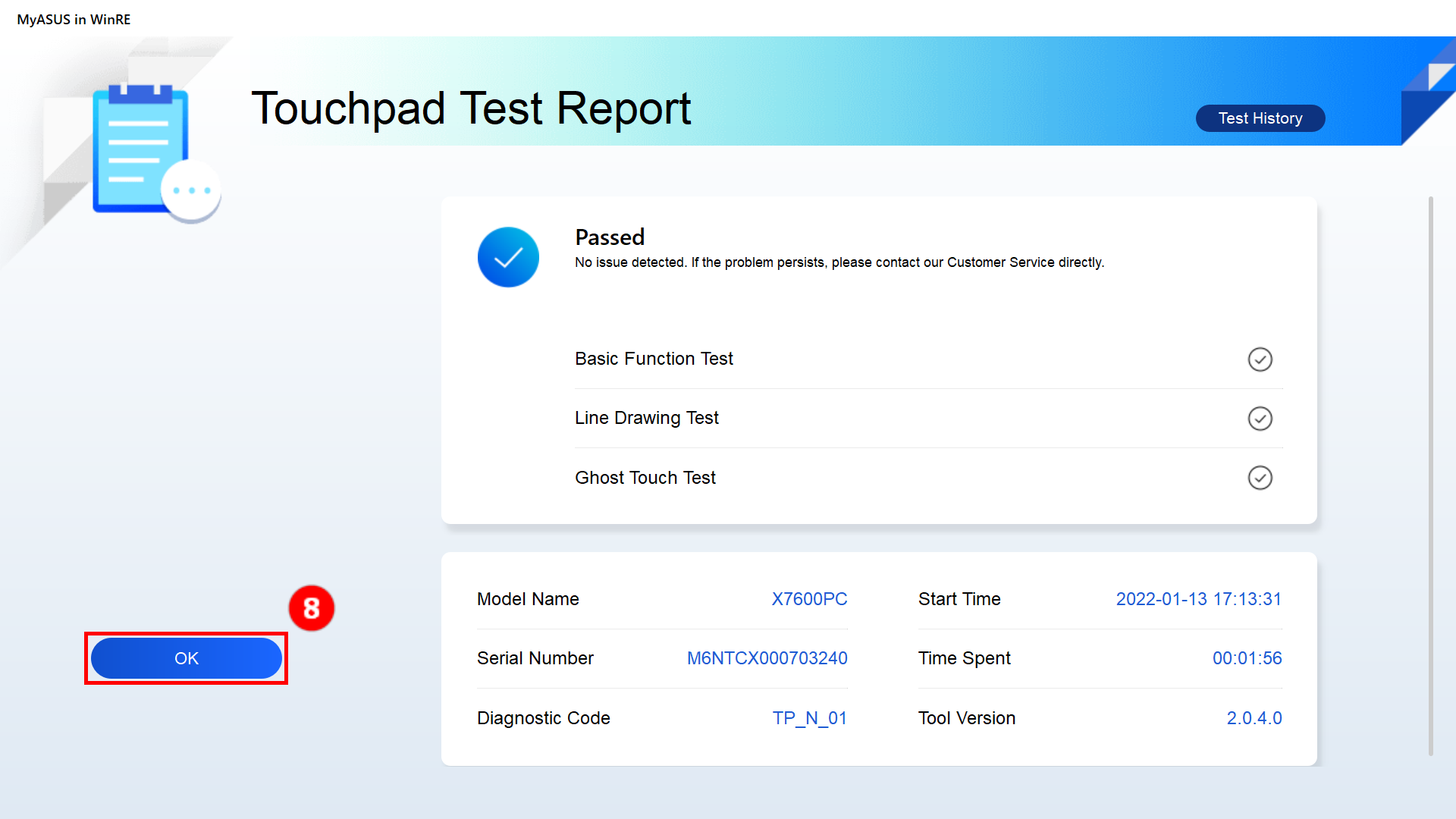
4. What should I do when "Failure" appears in the test report
First, please choose to agree in the "Privacy Statement" section 2.4 of this article. then use your mobile phone to scan the QR code (the QR code contains the machine code and the diagnostic code). The system will automatically generate a repair report for you. You only need to fill in your personal information, the computer status and pickup information, and ASUS will pick up and repair. (Note: Depends on the service policy of different regions)
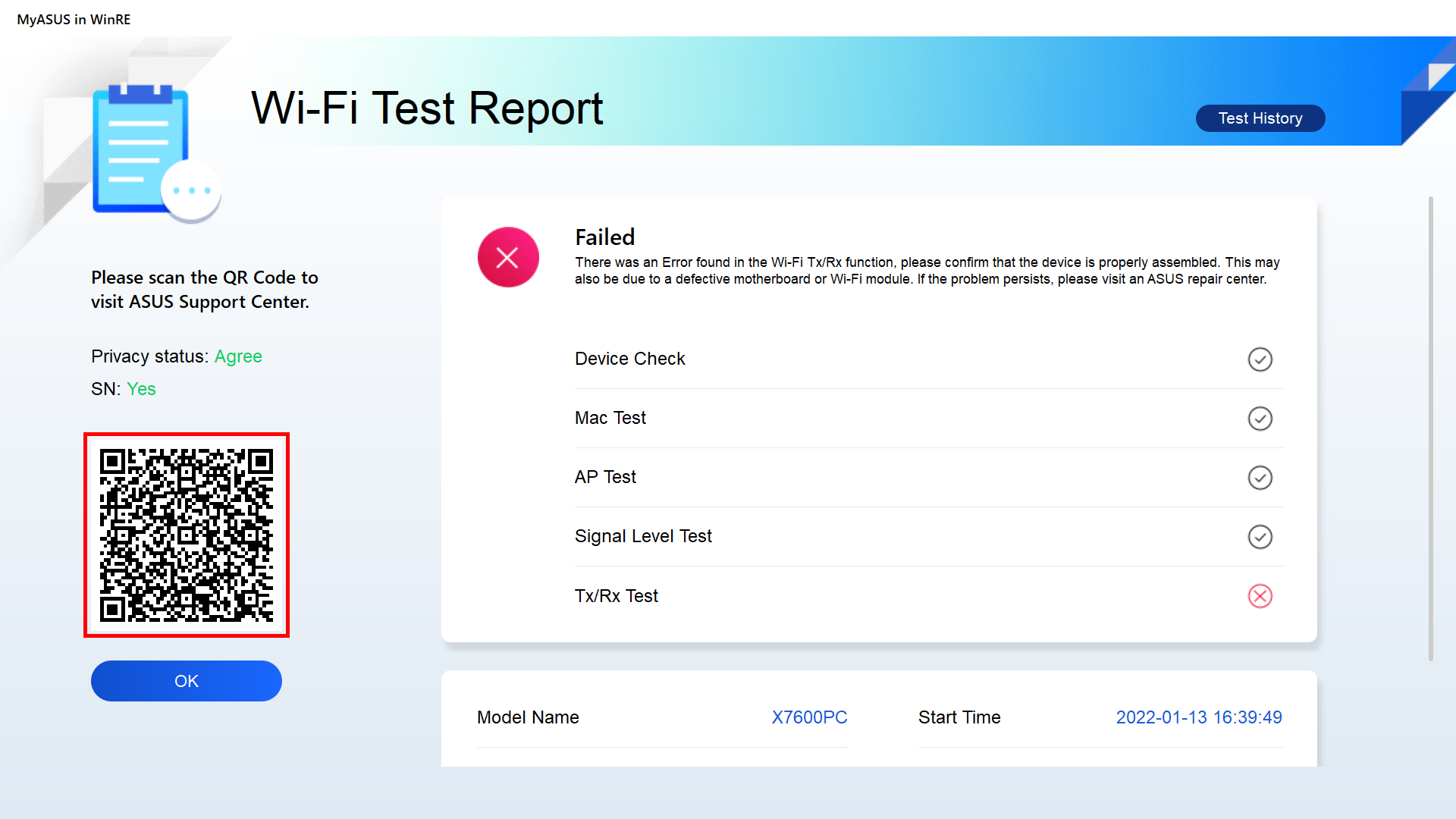
(1) Click [Test History]① and click on [one of the records]②.
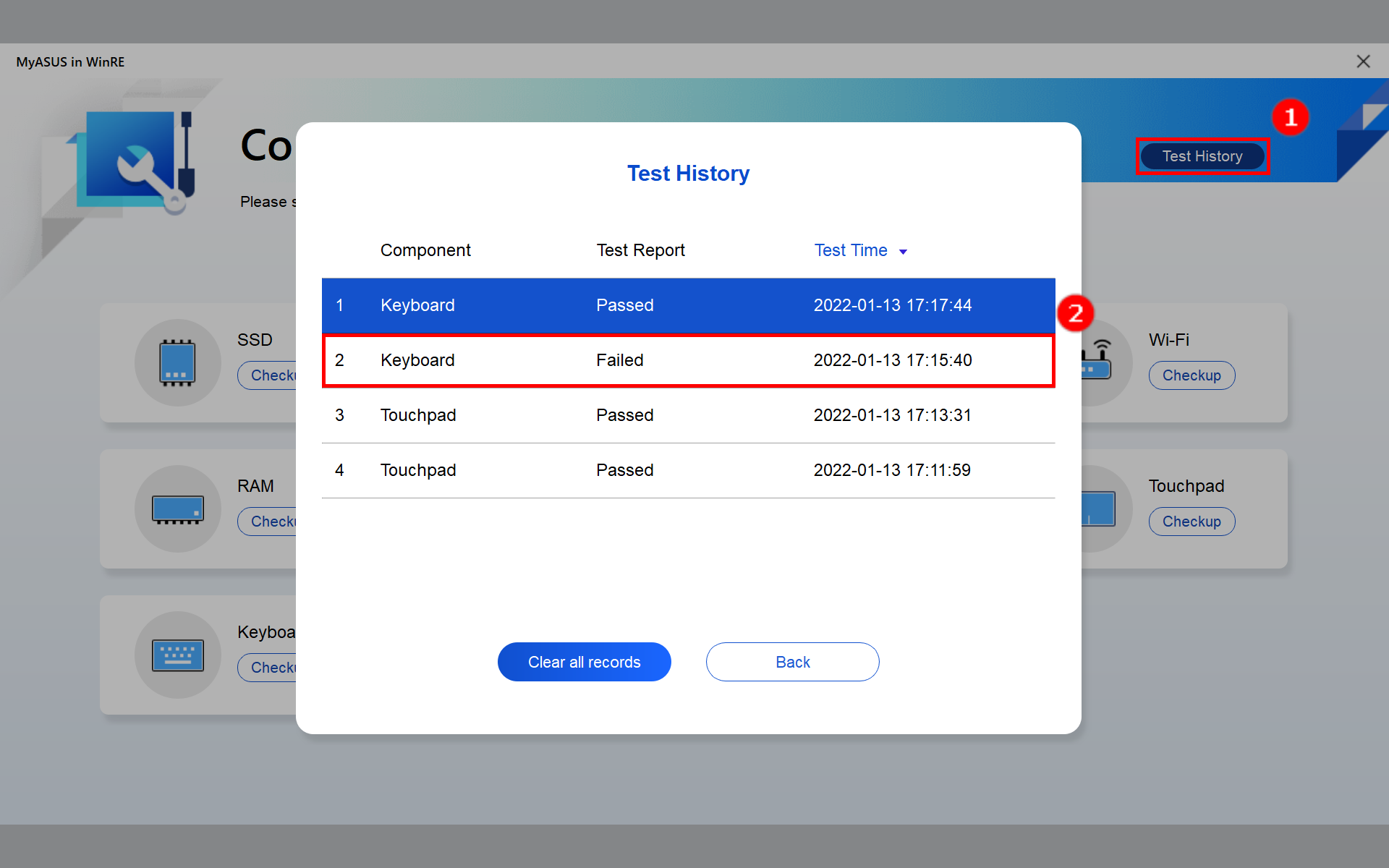
(2) A new pop-up window displays the specific [test information]③.
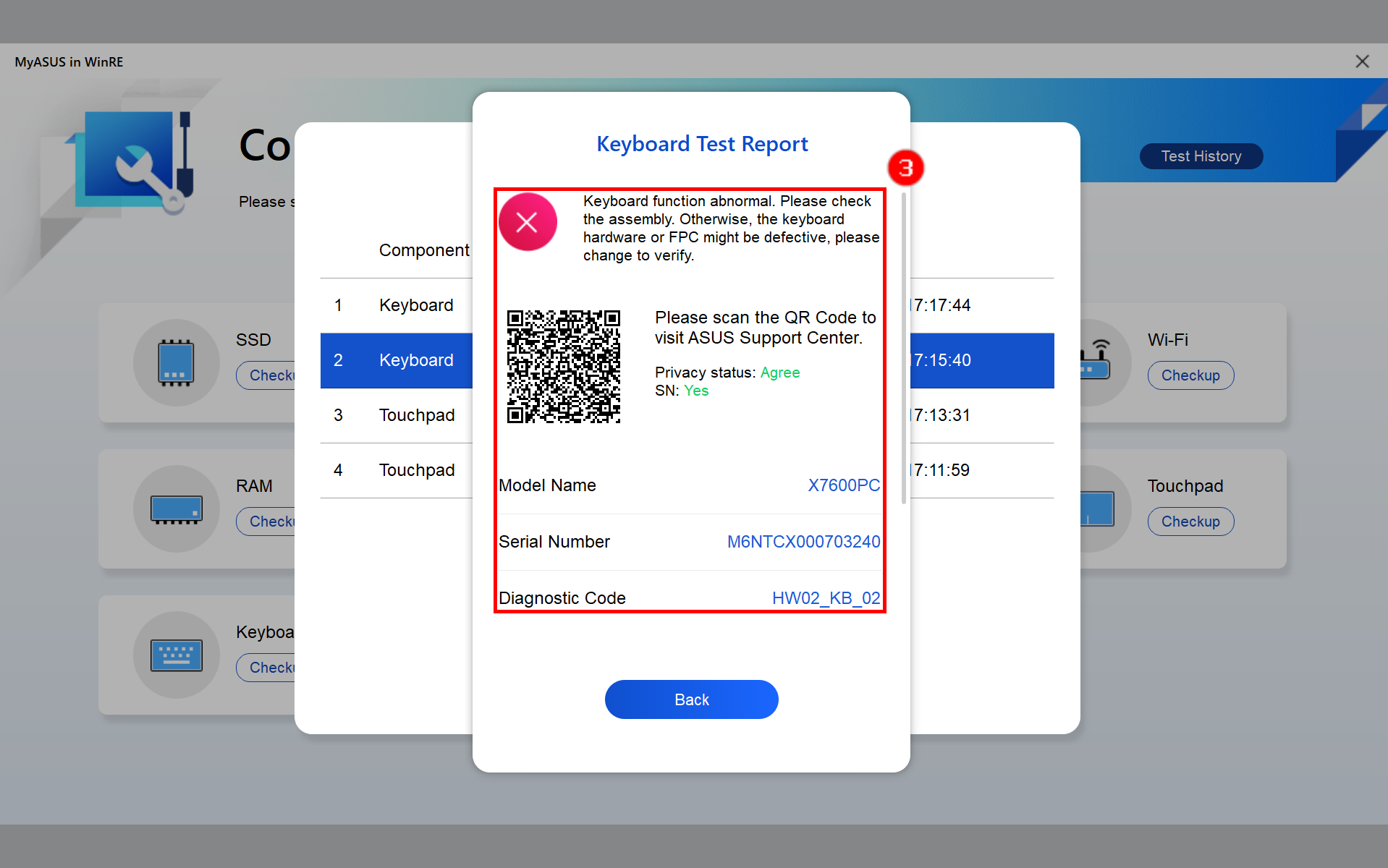
6. Notice - The meaning of the three test results:
- Pass: No problem is detected. This means that the test has completed and the result meets the standard. Please feel free to use it.
- Failed: Problem detected. It indicates that the test has completed and the problem has been detected. Please scan the QR code with your mobile phone and send it for repair as described in section 5 of this article.
- Warning: If the component cannot be detected or you abruptly terminate the test program during the detection process, a warning message will show up. Please check the components again or send them for repair.